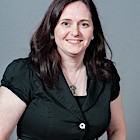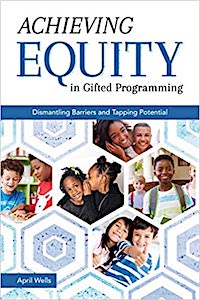Achieving Equity in Gifted Programming
Achieving Equity in Gifted Programming: Dismantling Barriers and Tapping Potential
By April Wells
(Prufrock Press, 2020 – Learn more)

Educational equity is a big topic, and one specific area of education in need of an overhaul is gifted education.
In my years of working with students identified as gifted, I saw a pretty monochromatic view of what it meant to be gifted according to schools. It predominantly meant white and upper-middle class.

Achieving Equity in Gifted Programming would be a valuable read for those who want to take on the intimidating but essential task of working toward equity in gifted programs.
Responding to national trends locally
In each chapter of the book, Wells delves into a specific topic, such as gifted student identification. She includes information about national trends in gifted education, how these often ineffective practices were evident within District U-46, and what steps were taken to address them and work toward better representation of CLED (culturally, linguistically, and economically diverse) students within the district.
Each chapter ends with reflection questions which challenge the reader to reflect on their specific locale and context and consider how to address inequities within their gifted programming. These reflection questions provide a framework that can be utilized for discussions with teachers and administrators program-wide as they collaborate to create more equitable approaches to identifying students, including them in gifted programs and assuring they have continuing support.
First steps toward equity
Among the actions taken by District U-46, a couple stood out as manageable, positive steps that most any mid-to-large school district could take to work toward more equitable representation in their gifted programs. Universal screening and utilizing building-level criteria instead of national norms to identify students for placement are great first steps to making your identified gifted population more reflective of the overall school population.
The use of multiple measures to identify students for gifted placement was another step that many schools are already using, but Wells pushes it further. She proposes that teachers, administrators, and parents be trained in the use of a checklist that serves as an additional measure for identification.
Helping talents emerge
In Chapter 4, Wells explores talent spotting – a bit of a revelation for me. She relates how District U-46 flipped the script from the typical model (identify students for gifted programming and then provide services) to a broader model of talent development, in which students are provided enrichment in order to nurture their talents and allow their gifts to emerge.
This talent development effort was focused on students in second and third grade and was supported by gifted specialists who pushed into each class weekly for 45 minutes and provided instruction in thinking skills, including evaluative and divergent thinking.
During these visits, the classroom teacher can make note of students’ skills that might otherwise go untapped. This can lead to more of these students being identified for gifted programming, as it provides opportunities to view student potential in a way that is unconnected to a specific academic subject area.
Looking beyond the urban setting
Wells left me with many ideas, as well as questions. Since I currently work in a predominantly rural state, I found myself wondering how some of the strategies implemented by District U-46 would translate to a more rural context.
For example, how does a school that consists of a dozen students in multiple grade levels determine building-level criteria for gifted identification? (Yes, I promise, we really do have this in Montana and other states!) How can talent development be integrated into schools that do not have access to a gifted program specialist to support this very specific approach to nurturing student potential?
Finally, I found myself wanting to know more (much, much more!) about the bilingual gifted program offered by District U-46.
Although Wells states that the overarching framework is the same as the English-only program, I would like to know more about how this program was created, how the district balanced the language of instruction, and what elements of culturally responsive teaching were integrated into this program. This could be another entire book, and I would jump at the chance to learn more!
Sarah E. Pennington taught middle school language arts for a decade before returning to school to pursue her doctoral degree in curriculum and instruction. She is currently an assistant professor at Montana State University, where she teaches pre-service educators the ins and outs of supporting young literacy learners. She also provides professional development in literacy and motivation to teachers across the nation.






























